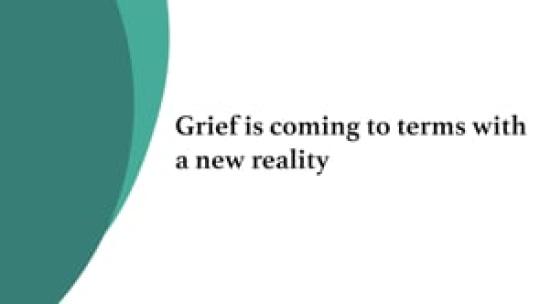What is grief...
Grief is not one single emotion but rather is an experience and a process that encompasses all of the different thoughts, feelings, and reactions we might encounter in response to a loss. There is no formula or single path to this process as everyone grieves differently. While each individual’s grief is unique, there are certain commonalities people might experience while navigating grief... some of which we touch on below.
How people grieve
Few people go through life without experiencing the death of someone they love. Death is a part of life, and at some point we all face it. Through the process of grieving we learn how to cope with the future in spite of our loss. How well we manage this affects our quality of life and our ability to relate to others.
A century ago, death was a big part of people’s lives. There were mourning rituals and death was talked about more openly. This is still the case in some cultures. Bereaved families and individuals tell us that talking about death and the person who has died helps with their grief. The worst thing for them is people ignoring the death. Acknowledging the death, and finding ways of expressing painful feelings, can help in your grieving process.
The tasks of grieving and mourning
Research and the experience of bereaved individuals shows that grieving, the emotional process that takes place after someone significant dies, is very important. There is no set path or pattern to this process, as everyone grieves differently. However, most grieving people experience some or all of the following. The order of these is not set, as people usually move back and forth between these feelings.
Facing reality
Initially you are likely to be in a state of shock, even when a death has been anticipated. You may feel faint, cry uncontrollably, feel out of control or even collapse. Or you may be so numb that you display no emotion at all and appear very controlled, calm and detached. This initial numbness may last several days, and it can be a form of emotional protection which helps you to deal with all the necessary practicalities like coping with the funeral.
The more traumatic the loss, the more prolonged this numbness is likely to be. You may not want to accept what has happened and may cope by denying it or refusing to talk about it. However, it is important to find ways to gradually accept the death and the fact that the person can never return.
Viewing the body of the person who has died, getting involved in the preparations for the funeral and observing rituals and traditions may help you to face the reality of what has happened.
Experiencing the pain of grief
Once the immediate feelings of shock settle, you may feel overwhelming grief for a long time after the death. Your grief may be so strong so that you are incapable of thinking about anything or anybody else but your loss and grief. You may find yourself getting upset or angry about things that you wouldn’t normally.
A bereaved mother told us she felt that she ‘had one layer of skin less’ when she was describing how upset she got about things.
As well as feelings of extreme sadness, you may feel guilt, anger or resentment. Many people struggle with guilt or regret about some aspect of their relationship with the person who died. Perhaps you left your true feelings unsaid or said things you did not really mean. Some people feel they hadn’t spent enough time with the person or really listened.
You may feel anger towards the person for leaving you to cope with life on your own, anger at the medical team for not curing the illness or not keeping them alive, or anger at God for letting it happen. In some cases, people can feel resentment towards a family member who they feel contributed in some way to the death.
Grief is not a mental illness, although sleeplessness, anxiety, fear, anger and being preoccupied with your emotions can all add up to a feeling of ‘going mad’. These feelings are natural and, when acknowledged, can become less frequent over time. Expressing grief is healthy and attempts to avoid these feelings can cause problems in the future. If you feel you are suppressing your grief, or your anger or guilt continues for a long time or takes over from other feelings, you may want to consider seeking support from a trained professional.
Adjusting to a new reality
Facing life without someone important to you is a difficult and painful process. No one can fill the place they had in your life and each day can bring constant reminders of their absence. Just getting through the day can be a difficult task. The future may seem uncertain or even frightening. It can take many months before you are able to dwell less on the sad events surrounding the death and start to function more as you did before.
Maintaining connection and looking to the future
Reinvesting in the future involves continuing life without the person and starting to also focus on other things. It can feel like a betrayal and is perhaps the most difficult task of all. However, reinvesting in the future is not about forgetting. It is about finding ways of remembering and maintaining a connection with the person, in ways which comfort you and are important, but which fit in alongside other important things in your life.
The sadness remains but becomes part of an adjusted life, and you can look to the future, while still recalling happy times spent with the person who has died and taking pleasure in those memories. You start to gain more control and life becomes more meaningful. You will find you are not as consumed by your grief but can choose when you want to reflect on your relationship with the person who died. It is natural at anniversaries or special occasions for feelings of grief to surface again and to be as vivid as on the day the person died.
Dual processes
Loss-oriented and restoration-oriented processes
Stroebe and Schut's dual process model of coping with bereavement (1999) suggests that death and loss are associated with many stressors, adjustments, and transitions.
Loss-oriented coping processes involve facing and acknowledging grief and loss head-on. These processes center around focusing on the loss of the person who has died and the relationship with that person. Loss-oriented processes include things like:
- Crying and sadness
- Yearning for the deceased or what was lost
- Experiencing sadness, denial, or anger
- Dwelling on the circumstances of the death
- Avoiding activities that move toward restoration
Restoration-oriented coping processes involve focusing on what is needed to survive and move forward following a death or loss. Often, restoration-oriented coping processes involve dealing with the secondary losses (e.g., loss of social connection, loss of financial security) that are incurred following the primary loss of a loved one. Restoration-oriented processes involve adjusting to changes to lifestyle, routine, and relationships. Restoration-oriented processes include:
- Adapting to a new role
- Managing changes in routine
- Having to fulfill tasks that the person who died used to do
- Developing new ways of connecting with family and friends
- Cultivating a new way of life.
Ultimately, we suggest that grief is best supported by allowing families to oscillate between the loss-oriented and restoration-oriented coping processes described above. In other words, sometimes families need to focus on the death or the loss of a future they imagined; at other times, families need to focus on what they need to do to move forward with their lives. Sometimes, families need to take a break from grieving altogether. All of this is normal and deserves a place in the treatment they receive in their healthcare settings and communities.
A note on children
If adults allow, children are naturals at managing this oscillation between loss-oriented and restoration-oriented processes. Whereas adults can sometimes get 'stuck' in either loss-oriented or restoration-oriented processes, children are often much more quick to move from one to the other. A helpful way to think about this is as “puddle-jumping” from being in the sadness and with their feelings to then quickly moving to playing, getting on with things, and just being kids.
Importantly, children need permission and space to engage in this 'puddle-jumping.' This can be hard for adults because our natural instinct is often to protect children. We may find ourselves wishing we could prevent them from being sad (or engaging in loss-oriented processes). As healthcare providers, it is critical to help families recognize the importance of allowing children to oscillate between loss-oriented coping and restoration-oriented coping processes.
Life grows around grief
Grief does not necessarily 'end' in the way that theorists once thought. In fact, grief does not always result in a resolution where sadness and pain are gone and done with.
Indeed, as noted in the section above above, grieving people hopefully engage in restoration-oriented processes that involve getting on with daily life. Grieving people, and the people who support them (including healthcare professionals), may mistakenly hold an expectation or wish that while grief may begin begin as all-consuming and overwhelming, it should shrink over time to become processed, tidy, encapsulated, and manageable.
However, in reality, grieving people often describe that although over time their lives have grown in many real and meaningful ways, their grief often felt as big and present as ever. Tonkin (1996) thus developed a model depicting how grief remains the same size over time and life grows around grief. This model helps to relieve grieving people of the expectation that their grief needs to go away, and it helps to ease the sense of disloyalty that a grieving person may feel when 'moving on' with their life. The simple graphic below may help you understand the experience of your patients and families, and you may wish to use it in your practice in discussion with patients and families so they can better understand their own experiences as well.

